List of Philippine flags
This is a list of flags used in the Philippines.
National flag
| Flag | Date | Use | Description |
|---|---|---|---|
 |
1998–present | National flag of the Philippines | A horizontal bicolor of equal bands of blue and red, with a white equilateral chevron spanning the width of the hoist. Within the chevron are three five-pointed stars (fixed on each of the vertices), and a sun with eight major rays (set in the center), all in yellow. |
Governmental flags
| Flag | Date | Use | Description |
|---|---|---|---|
| Executive branch | |||
 |
2004–present | Flag of the president of the Philippines | The coat of arms of the president of the Philippines against a blue field. The number of stars correspond to the number of provinces. |
 |
2004–present | Flag of the vice president of the Philippines | The presidential arms against a white field. |
 |
1946–1947 | Flag of the president of the Philippines | The coat of arms of the Philippines against a blue field with four golden stars on each corner. |
 |
1947–1951 | Flag of the president of the Philippines | The presidential arms (minus the circle of stars) against a blue field with four golden stars on each corner. |
 |
1951–1979 | Flag of the president of the Philippines | The 1948 design, with the four golden stars replaced by a ring of golden stars. The number of stars theoretically changed as the number of provinces changed.[1] |
 |
1980–1986 | Flag of the president of the Philippines | The flag's shade became a lighter blue, and the red triangle was inverted. The sea-lion was replaced by a golden eagle, bearing three branches and arrows, and the ring of stars were changed to white. |
 |
1986–2004 | Flag of the president of the Philippines | The coat of arms of the president of the Philippines with white as the color of the stars against a light blue field. |
 |
1986–2004 | Flag of the vice president of the Philippines | The former vice presidential seal against a white field. |
| Legislative branch | |||
 |
1987 | Flag of the president of the Senate | The seal of the Senate against a red field. |
 |
1987 | Flag of the speaker of the House | The seal of the House of Representatives against a yellow field. |
| Executive branch | |||
 |
1987 | Flag of the Department of Health | The seal of the Department of Health against a yellow field. |
 |
1987 | Flag of the Department of Science and Technology | The logo of the Department of Science and Technology against a white field. |
 |
1986 | Flag of the Department of Tourism | A horizontal triband of yellow (top and bottom) and white with the seal of the Department of Tourism centered on the white band. |
 |
1987 | Flag of the Department of Finance | The seal of the Department of Finance against a violet field. |
 |
1987 | Flag of the Department of Agriculture | The logo of the Department of Agriculture with the department's name in both Tagalog and English in Times New Roman against a white field. |
 |
2022 | Flag of the Department of Migrant Workers | The coat of arms of the Philippines with the department's name in Old English Text against a white field. |
| Judicial branch | |||
 |
1946 | Flag of the Supreme Court | The seal of the Supreme Court against a purple field. |
 |
1978 | Flag of the Sandiganbayan | The seal of the Sandiganbayan against a maroon field. |
 |
1946 | Flag of the Court of Appeals | The seal of the Court of Appeals against an olive green field. |
 |
Flag of the Court of Tax Appeals | The seal of the Court of Tax Appeals against a sky blue field. | |
| Other government offices | |||
 |
Customs ensign | Navy blue and white vertical bands with a white canton bearing a gold sea-lion bearing a sword. | |
 |
Flag of the Metropolitan Manila Development Authority | Seal of the MMDA on a white field. | |
 |
Flag of the DPWH-ARMM / Ministry of Public Works of Bangsamoro | Seal of the regional office/ministry on a sky blue field. | |
Military flags
| Flag | Date | Use | Description |
|---|---|---|---|
 (1936–1985, 1986–1998)  (1998–present) |
Only during a state of war | State and War flag | The national flag, hoisted with red and blue fields inverted, unique among the national flags. |
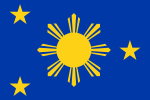 |
Naval ensign and jack | Eight-rayed golden sun and three stars of the national flag on an azure field. | |
 |
2005–present | Flag of the Philippine Armed Forces | Coat of arms of the Armed Forces of the Philippines on a triband field that consists the color: navy blue, dark blue, and army green that represents the 3 main branches of the Philippine Armed Forces. |
 |
2005–present | Flag of the Philippine Army | Seal of the Philippine Army on a dark green field. |
 |
2002–present | Flag of the Philippine Navy | Seal of the Philippine Navy on a dark blue field. |
 |
2005–present | Flag of the Philippine Air Force | Seal of the Philippine Air Force on a blue field. |
 |
2004–present | Flag of the Philippine Marine Corps | Coat of arms of the Philippine Marine Corps on a blue field, flanked by ribbons bearing the organization's name in English and motto in Tagalog. |
Philippine coast guard flags
| Flag | Date | Use | Description |
|---|---|---|---|
 |
1998–present | Flag of the Philippine Coast Guard | Seal of the Philippine Coast Guard on a dark blue field. |
Civil flags
| Flag | Date | Use | Description |
|---|---|---|---|
 |
1903–present | Coastwise Emblem of the Philippines | White flag with a blue and red star on the horizontal median line. |
Historical national flags
| Flag | Date | Use | Description |
|---|---|---|---|
| The Spanish East Indies (1565–1898) | |||
 |
1565–1762, 1764–1821 | Flag used when the Philippine Islands were a part of New Spain. | The Cross of Burgundy: a red saltire resembling two crossed, roughly-pruned branches, on a white field. |
 |
1762–1764 | Flag during the British occupation of the Philippines, as used in occupied Manila and Cavite. | The flag of the British East India Company before 1810: A flag with red and white stripes with the Kingdom of Great Britain's Union Flag as a canton. The Union flag bears red cross on a white field, commonly called St George's Cross, superimposed on a white saltire on a blue field, known as St Andrew's Cross. Also known as the "King's Colours". |
 |
1821–1873 | Used during Spanish East Indies period. | Three horizontal stripes of red, weld-yellow and red, the centre stripe being twice as wide as each red stripe with arms in the first third of the weld-yellow stripe. The arms are crowned and vertically divided, the left red field with a tower representing Castille, the right white field with a lion representing León. |
 |
1873–1874 | Used by the Spanish East Indies under the First Spanish Republic. | Three horizontal stripes: red, weld-yellow and red, the yellow strip being twice as wide as each red stripe with arms in the first third of the yellow stripe. Royal crown removed from arms. |
 |
1874–1898 | Used during Spanish East Indies after the restoration of the Spanish monarchy. | The flag of the Kingdom of Spain used prior to the First Spanish Republic was reinstated. |
| Philippine Revolution – First Philippine Republic | |||
 |
1898–1901 | The flag design was conceived by President Emilio Aguinaldo. The exact shade of blue is debated; many variants were used by subsequent governments. | Sewn by Marcela Marino de Agoncillo, Lorenza Agoncillo, and Delfina Herbosa de Natividad in Hong Kong and first flown in battle on May 28, 1898. It was formally unfurled during the Proclamation of Philippine Independence and the flag of the First Philippine Republic, on June 12, 1898 by President Aguinaldo. It contains a mythical sun (with a face) similar to the Sun of May in other former Spanish colonies; the triangle of Freemasonry; the eight rays representing eight rebellious provinces of the Philippines first placed under martial law by the Governor-General. Some flags carry the Spanish texts: Fuerzas Expedicionarias del Norte de Luzon on its obverse and Libertad Justicia e Ygualdad on its reverse, which means "Northern Luzon Expeditionary Forces" and "Liberty, Justice, and Equality" respectively. |
| American and Commonwealth Period (1898–1946) | |||
 |
1898–1908 | Used while under direct administration from the United States of America. | The Philippine Commission, passed Act No. 1697 or the Flag Law of 1907, which outlawed the display of the Philippine flag and replaced the country's flag to the stars and stripes of the United States of America. The same law prohibited the playing of the national anthem. Thirteen horizontal stripes of alternating red and white representing the original Thirteen Colonies; in the canton, white stars on a blue field, the number of stars increased as the United States expanded its territory. |
 |
1908–1912 | Variant after Oklahoma became a state | |
 |
1912–1919 | Variant after Arizona and New Mexico achieved statehood | |
  |
1919–1936 | From October 30, 1919,[2] two flags were flown in the Philippines: the American flag and the flag conceived by Emilio Aguinaldo which was made the national flag of the Philippines with the repealing of Act No. 1697.[3] | The American flag remained unchanged since 1919. For the Philippine flag, the design conceived by Emilio Aguinaldo remained but the shades of blue and red were adopted from the American flag. The sun's face was removed, but its stylized rays were retained. There existed many versions of the flag as no official design had been codified. |
 |
1936–1946 | Specifications standardized; Defined under Executive Order No. 23, s. 1936 which was signed on March 25, 1936. The de facto shade of blue used was Cable No. 70077 or "National Flag Blue" by the Reference Guide of the Textile Color Card Association of the United States.[4] The triangle was made equilateral and the sun's rays were also further simplified, achieving its present form. Also used by the Commonwealth government-in-exile from 1942 to 1945. | |
| Japanese Period (1942–1945) | |||
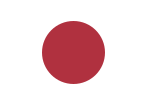 |
1942–1943 | Used during the Japanese Occupation. | The Japanese flag as it appeared until 1999: a red sun-disc, shifted 1% left of centre, on a white field. |
 |
October 14, 1943 | Used during the inauguration of the Second Republic. | Emilio Aguinaldo's flag was hoisted upon proclamation of the Second Republic. However, the design as used by the Commonwealth remained. |
| Sovereignty (1946–present) | |||
 |
1946–1985 | Following independence, the 1936 design specifications standardized by President Manuel L. Quezon sported a shade of blue currently called National Flag Blue. Initially having de facto standing, it was officially adopted in 1955. In 1985, the shade of blue was updated to Oriental Blue, this change would later be rescinded in favor of pre-1985 National Flag Blue.[5] In 1998, the flag gained its present definitive shade of blue currently called Royal Blue. | Defined under Executive Order No. 23, s. 1936 dated March 25, 1936. The shade of blue used here is Cable No. 70077 or "National Flag Blue" by the Reference Guide of the Textile Color Card Association of the United States. The particular shade of blue had de facto standing until January 24, 1955, when President Ramón Magsaysay upon the recommendation of the Philippine Heraldry Committee (PHC) officially adopted Cable No. 70077 or "National Flag Blue" as the official shade of blue to be used.[6][7] |
  |
1985–1986 | Executive Order No. 1010, s. 1985 was issued by President Ferdinand E. Marcos on February 25, 1985 instructing the National Historical Institute (NHI) "to restore the original color of the First Philippine Flag" amidst debate on the shade used in the original flag. The executive order declared that "the shade of the color blue was lighter than the present dark blue". The executive order did not specify a shade of blue to be adopted. A de facto version of the flag which featured a light blue was used in April 1985 despite NHI not having announced its recommendation. The NHI in May 1985, adopted Cable No. 80176 or "Oriental Blue" for the new national flag.[8] | |
 |
1986–1998 | 1936 version of the flag restored after the 1986 People Power Revolution. President Corazon C. Aquino restored the pre-1985 National Flag Blue specifications of the flag through Executive Order No. 292, s. 1987 which was signed on July 25, 1987.[9] | |
 |
1998–present | The Flag and Heraldic Code of the Philippines (Republic Act. 8491, s. 1998) specifies the colors for the blue field Cable No. 80173; the white field, Cable No. 80001; the red field, Cable No. 80108; and the golden-yellow Stars and Sun, Cable No. 80068. The colors were introduced in the same year that the Centennial celebrations were to take place.[10][11][12] | |
Regional flags
Among the country's 17 regions, only the Bangsamoro Autonomous Region in Muslim Mindanao has its own officially legislated regional flag. The purported flag of the Cordillera Administrative Region — which has no elected regional government that could legally specify the details of the reported emblem — has not been attested.[13]
| Flag | Date | Use | Description |
|---|---|---|---|
 |
1992–2019 | Regional flag of the Autonomous Region in Muslim Mindanao | A horizontal tricolor of equal blue (top), white (middle) and red (bottom) stripes. Top stripe bears one yellow five-pointed star; the middle stripe, a green circle filled with yellow elements — a tilted crescent moon nearly enclosing four smaller five-pointed stars; the bottom stripe, a silver kris.[14] The number of smaller stars, meant to represent the number of the region's constituent provinces, has de facto varied from four (1992–2001), to five (2001–2006), to six (2006–2008) to five again (2006–2019), but because the flag specifications contained within the 1992 law (Muslim Mindanao Autonomy Act No. 12) were not amended the original flag remained the only de jure official design.[15] |
 |
2019–present | Regional flag of the Bangsamoro Autonomous Region in Muslim Mindanao | A horizontal tricolor of equal green (top), white (middle) and red (bottom) stripes. Charge in the center of the middle stripe is a yellow crescent moon enclosing a seven-pointed star.[16] |
 |
1988–1995[13] | Purported[13] flag of the Cordillera Administrative Region | A horizontal bicolor of green (top) and yellow (bottom), centered upon which is a charge consisting of a Cordillera warrior shield bearing the CAR Regional Development Council (RDC) logo adopted in 1988, when Kalinga–Apayao was still a single province.[13] |
Provincial flags
Municipal and city flags
Like the flags of most Philippine provinces, flags of cities and municipalities usually just bear the seal of the municipality or city on a single or multi colored field, but there are some municipal or city flags that differ from the standard. All municipalities in the province of Camarines Norte and Aklan bear flags that differ from the standard.
| Flag | Date | Use | Description |
|---|---|---|---|

|
Municipal flag of Balilihan, Bohol | ||

|
Municipal flag of Garcia Hernandez, Bohol | ||

|
2003–present | Municipal flag of Kalilangan, Bukidnon | Blue and green horizontal stripes with a white canton bearing a sun surrounded by 14 stars. Adopted on June 9, 2003 through Municipal Council Resolution No. 2003-315.[17] |
| Municipal flag of Maribojoc, Bohol | Stripe of green, white, and blue with a sun in the middle bearing the silhouette of a church | ||
| Municipal flag of San Mateo, Rizal | Light sky blue field with a white stripe on the center bearing an eight-pointed sun and a palm frond | ||

|
Municipal flag of Bustos, Bulacan | ||

|
1995–present | Flag of Cavite City | |

|
Flag of Mandaluyong |
Other historical flags
| Flag | Date | Use | Description |
|---|---|---|---|

|
c. 1515–1888 | Flag of the Sultanate of Maguindanao | A plain yellow flag |

|
1762–1763 | Flag of the Palaris Revolt | "...it was two "varas" long and a trifle more narrow; at each corner it had a two-headed eagle, and in the center an escutcheon with its border, and within it the Arms of the Dominican Order..."[18] |

|
18th century | Flag of the Sulu Sultanate | Flag of Sulu Sultanate according to Pierre Sonnerat |
 
|
1807 | Flags of the Basi Revolt | |

|
1845–1898 | Provincial ensign of the province of Manila | |

|
1886–1898 | Provincial ensign of IloIlo | |

|
1872 | Flag of the Cavite Mutiny | |

|
Late 19th century | Flag of the Sulu Sultanate | |

|
1898 | Flag of the Negros Revolution | Banner used by Negrense revolutionaries during their revolution |

|
1898–1901 | Flag of the Republic of Negros | |

|
1902–1906 | Flag of the Tagalog Republic | |
| 1956–1974 | Flag of the Free Territory of Freedomland | The flag of Freedomland, a micronation founded by Tomas Cloma in the Spratly Islands (Kalayaan, Palawan) |
Political flags
| Flag | Date | Use | Description |
|---|---|---|---|
| Current | |||

|
2012–present | Flag of the Maute group, Khalifa Islamiyah Mindanao and Ansar Khalifa Philippines | |

|
2001–present | Flag of the MNLF Executive Council of 15 | |

|
1996–present | Flag of the Moro National Liberation Front | |

|
1995–present | Flag of the Revolutionary Workers' Party | |
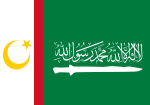
|
1977–present | Flag of the Moro Islamic Liberation Front | |

|
1973–present | Flag of the National Democratic Front of the Philippines | |
| Link to file | 1969–present | Flag of the New People's Army | |
 
|
1968–present | Flags of the Communist Party of the Philippines | |
| Former | |||
  
|
1986 and 1990 | Proposed flags of the Federal Republic of Mindanao | |

|
1986–2011 | Flags of the Cordillera People's Liberation Army | |
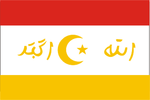
|
1968–1969 | Flags of the Muslim Independence Movement | |

|
1942–1945 | Flag of the KALIBAPI | |

|
1942–1954 | Flag of the Hukbalahap | |

|
1941–1945 | Flag of the Wha-Chi | |
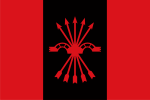
|
1936–1945 | Flag of the Philippine Falange | Falange flag used in the Philippines |
Flag proposals
| Flag | Date proposed | Use | Description |
|---|---|---|---|
 |
1998, 2008 | National Flag | Ninth ray for the flag's sun |
 |
2014 | National Flag | Emmanuel L. Osorio's proposal. Addition of a ninth ray to represent the Muslim and indigenous people and a fourth star for Sabah. |
See also
- Flag of the Philippines
- Coat of Arms of the Philippines
- Flags of the Philippine provinces
- Flags of the Philippine Revolution
Notes
References
- ^ "Philippines: President and Vice President". www.crwflags.com.
- ^ "Today in History". Presidential Museum and Library. October 30, 2013. Archived from the original on May 10, 2016. Retrieved June 12, 2016.
- ^ "Act No. 1696, s. 1907". Official Gazette of the Republic of the Philippines. Supreme Court Library. August 23, 1907. Retrieved June 12, 2016.
- ^ Agbayani, Eufemio III (May 29, 2021). "1985: A Year of Three Shades of Blue". National Historical Commission of the Philippines. Retrieved August 14, 2021.
- ^ Agbayani, Eufemio III (May 29, 2021). "1985: A Year of Three Shades of Blue". National Historical Commission of the Philippines. Retrieved June 3, 2021.
- ^ Agbayani, Eufemio III (May 29, 2021). "Construction Sheet: Philippine Republic Flag". National Historical Commission of the Philippines. Retrieved August 14, 2021.
- ^ Agbayani, Eufemio III (May 29, 2021). "1985: A Year of Three Shades of Blue". National Historical Commission of the Philippines. Retrieved August 14, 2021.
- ^ Agbayani, Eufemio III (May 29, 2021). "1985: A Year of Three Shades of Blue". National Historical Commission of the Philippines. Retrieved August 14, 2021.
- ^ Agbayani, Eufemio III (May 29, 2021). "1985: A Year of Three Shades of Blue". National Historical Commission of the Philippines. Retrieved August 14, 2021.
- ^ "Republic Act No. 8491". Government of the Philippines. February 12, 1998. (archived from the original Archived December 5, 2007, at the Wayback Machine on December 5, 2007).
- ^ "The Philippine National Flag" (PDF). Monuments and Heraldry division, National Historical institute. National Commission for Culture and the Arts. Archived from the original (PDF) on January 27, 2012.
- ^ "Flag of the Philippines". Encyclopedia Britannica. Retrieved February 19, 2021.
- ^ a b c d "CAR flag discussion". Philippine Vexillological Association. June 10, 2017. Retrieved December 18, 2019.
- ^ "Muslim Mindanao Autonomy Act No. 12 – An Act adopting an official regional emblem for the Autonomous Region in Muslim Mindanao and appropriating funds thereof" (PDF). ARMM Regional Legislative Assembly. July 16, 1992. Archived from the original (PDF) on September 8, 2016. Retrieved November 14, 2017.
- ^ Villapando, J.A. (November 15, 2017). "Flag of the Autonomous Region in Muslim Mindanao". Philippine Vexillological Association. Retrieved November 16, 2017.
- ^ Kar, Nilay (August 24, 2019). "Philippines: Official flag of Bangsamoro adopted". Anadolu Agency. Retrieved August 24, 2019.
- ^ "Municipality of Kalilangan Socie-Economic Profile 2010". Municipality of Kalilangan, Bukidnon. Retrieved June 4, 2018.
- ^ "Watawat: Flags and Seals of the Pearl of the Orient seas". Pablo Paddeu. Retrieved June 10, 2020.

